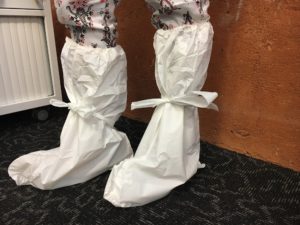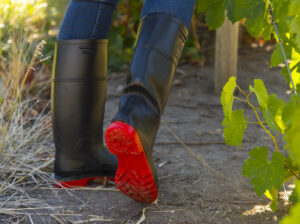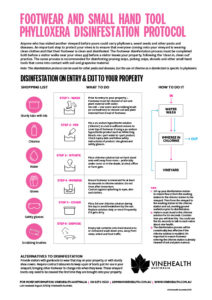Pests, diseases and weeds can be picked up and spread on footwear. For this reason, it’s important to ensure your footwear is clean and free of pests, diseases and weed seeds before allowing entry into your vineyard.
Your choices are:
Footwear disinfestation
The active ingredient you use as part of your sterilisation of footwear needs to be specific to the pest, pathogen, disease or virus you are aiming to kill, or it is unlikely to be effective.
Phylloxera is very difficult to kill and only very few active ingredients have been proven effective against this pest. Disinfestation using bleach has been proven effective to kill phylloxera.
Set up your disinfestation station as two step process:
- Clean off soil and plant material on the footwear using water and detergent. This will reduce soiling of the disinfestation solution and prolong its efficacy.
- Disinfest according to the Footwear and Small Hand Tool Disinfestation protocol.
Footbath tips
- Preferably set up in shade or under cover.
- Use multiple stations of the two-step process for larger groups.
- Cover tubs when not in use, as this will reduce the rate of chlorine breakdown by sunlight and heat, and maximise the efficacy of the chlorine solution.
- Change solution at least daily.
- Manage traffic flow to avoid cross contamination.
- Dispose of well away from vines and trafficked areas, e.g., on fence line.
- Do not rinse footwear with water after disinfestation as you will reduce the efficacy of the disinfestation step.
Bleach strength
Bleach strength and duration are VITAL to ensuring efficacy.
- Active ingredient of 40g/L (+) of sodium hypochlorite (generic and branded options available).
- Make dilution (bleach:water) easy for yourself by choosing simple volumes to work with – e.g., 2L containers rather than 2.5L.
- Calculate total liquid volume required in your footbath tub prior to purchasing to ensure coverage of the footwear.
Options
- 1:1 40g/L sodium hypochlorite to water. Time: 60 seconds
- 40g/L sodium hypochlorite undiluted. Time: 30 seconds
- 5% Dettol undiluted. Time: 60 seconds
- 95% methylated spirits undiluted. Time: 30 seconds. Caution: flammability
Single use shoe covers

In some cases, disposable shoe covers can be used as an alternative to footwear disinfestation. Click here for our current preferred shoe cover supplier. Search for ‘Pro Val CPE Heavy Duty Boot Covers’. We wear two of these shoe covers per foot because they are prone to rip. We are continuing the search for more robust shoe covers.
An alternative to footwear disinfestation and disposable shoe covers is to provide footwear to visitors or staff that remains on your site.
Vinehealth Australia is currently working with Small Design Co Pty Ltd on a project to develop a footwear solution for vineyard use. Read about the project here.
On-farm footwear

You can also provide footwear such as gumboots for visitors to use while on your property, that doesn’t leave your property.
Require contract labourers to keep a pair of boots just for use in your vineyard, bringing other footwear to change into when they leave. Such vineyard boots only need to be cleaned and sterilised the first time they are brought onto your property.
